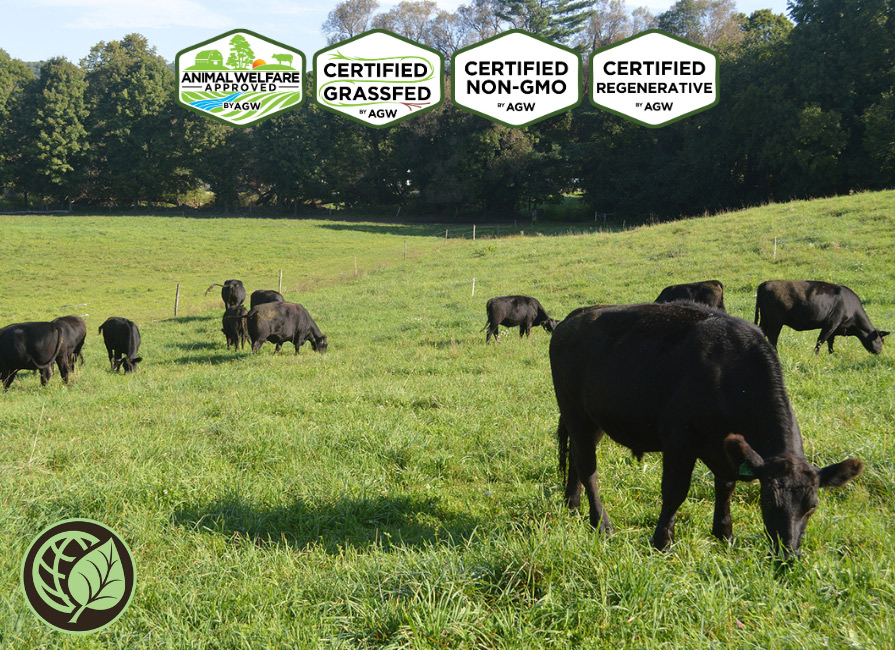One of the key attractions of our Certified Regenerative by AGW program is its practical…
Not all Organic is Equal–Final chance to let the NOSB know what you think!
 When you buy organic meat and dairy products, you probably have certain expectations about how they were produced and how the animals were raised.
When you buy organic meat and dairy products, you probably have certain expectations about how they were produced and how the animals were raised.
You may expect that animals on organic farms would be raised with the highest welfare in mind, with lots of space and free access to pasture. You may expect that all organic farmers would be caring and conscientious enough to allow organic animals to exhibit their natural behaviors. You may expect that organic farms would be far superior to industrial farms and concentrated animal feeding operations (CAFOs).
Sorry to dash your hopes, but all organic farmers do not necessarily raise their animals with even Big Ag’s welfare standards as a base. It might surprise you to know that the United States National Organic Program (NOP) – the federal regulatory framework that governs organic food and farming in the U.S. – has no specific rules on the amount of space that organic farmers are required to give their animals whenever they are housed indoors. This obviously raises questions about animal welfare.
Fortunately, plans were announced earlier this year to remedy this regrettable situation. The Livestock Committee of the National Organic Standards Board (NOSB) is responsible for making recommendations to ensure that livestock standards are implemented to maintain both organic standards for consumers and good living conditions for the animals. The Committee has now put forward a raft of changes to organic regulations that include new rules on space requirements for organic livestock.
One would presume that the NOSB’s recommendations would automatically represent a welcome step forward in terms of organic farm animal welfare. But the shocking reality is that the NOSB’s recommendations on space requirements for organic systems mean that some organic animals could actually have less space than you’d find in an industrialized intensive farming system, leaving consumer expectations – and the animals themselves – quite literally squashed.
In its recommendation document, NOSB notes that: “Animal welfare is a basic principle of organic production…it is our intention to create a comprehensive animal welfare program that benefits both livestock and farmers.” The document goes on to say: “Ultimately, the Livestock Committee would like the organic seal to be the gold standard, indicating the most nutritious food produced in the safest and most humane manner.”
At Animal Welfare Approved, we agree that the highest levels of animal welfare should form the very foundation of all organic farming systems. But if the NOSB’s starting point is the space recommendations proposed, the Board has a very long way to go before it can claim to have a program that truly benefits organic animal welfare – let alone sets the gold standard for humanely produced food.
When it comes to certified organic livestock standards, surely it isn’t too much to ask that the space given to organic animals is at least equivalent to the space given to non-organic livestock? That is surely a no-brainer, right? Wrong again.
While the NOSB’s recommendations for organic pigs require that farmers provide both an outdoor area and an indoor area for their pigs, if you add these two areas together, the total NOSB recommended area for an organic pig is actually less than the total indoor area that the National Pork Board requires for its non-organic, indoor, intensively raised pigs. Yes, you read that right: the NOSB’s recommendation on the space required for organically raised pigs is actually less than that required for many intensively farmed pigs.
Let’s take a closer look at those space recommendations for organic pigs. Under the NOSB’s recommendations, organic farmers would have to provide a twenty four pound pig with just one square foot of space indoors and 0.5 square foot outdoors. Think about just how small one square foot actually is. We’re talking about a space that is a little bigger than a sheet of letter paper. Is this seriously an example of the gold standard when it comes to animal welfare? Does the NOSB really think that this is the kind of space that consumers expect organic animals to have lived in? It’s absolutely disgraceful.
Time and time again, the NOSB’s public statements are completely at odds with its recommendations. On poultry, the board says: “A minimum of 2 square feet per bird is required to protect the soil and to minimize parasite loads via paddock rotation.” And indoors the space required can be as little as 1 square foot per bird. At Animal Welfare Approved, we know that keeping appropriate numbers of animals in a given field space, combined with a strategy of moving animals regularly around the fields on the farm, can massively reduce the incidence of parasites and other health and disease problems, as well as allowing birds and animals to perform their natural behaviors. But allowing two square feet per bird is not nearly enough space to achieve these benefits. Not even close.
It is hard to understand why NOSB has made its recommendations so low. The organization states that: “The less space provided per animal, the more labor-intensive it may be to keep them clean and in good health…” and that “…outdoor access is important for all livestock to enhance muscle tone and relieve boredom.” Yet these good intentions amount to nothing if the recommendation that comes out of them means that organic pigs have less indoor space than non-organic intensively farmed pigs, or if organic chickens have only one square foot per bird for outdoor access.
Regarding the NOSB’s statement about the less space an animal has, the harder it is to keep it in good health…we wholeheartedly agree. It has been shown repeatedly that animals in cramped, stressful conditions are more susceptible to disease. Since organic standards prohibit the use of antibiotics – even when an animal is sick – you would think that the NOSB’s recommendations on the numbers of animals that farmers can keep indoors would be set at a level to promote health, not to actively compromise it.
Do these proposed stocking densities reflect the reality of what is actually provided for organic livestock? I know many certified organic farmers who are farming in the organic spirit, who pride themselves on the highest welfare standards, and whose livestock housing facilities already far exceed the NOSB’s inadequate recommendations. Many of these farmers are also part of the Animal Welfare Approved program – a clear statement of their dedication to providing their animals with the highest standards of welfare.
But while there are many reputable organic farmers who are passionate about the organic ethos, I am afraid that there are also some who are only interested in providing the bare minimum of space for their livestock. These businesses will certainly not want to make massive investments to increase their housing space, nor will they want to decrease their current stock numbers to meet any new space requirements. Is this what has driven the NOSB Livestock Committee to make such weak recommendations? Whatever the motivation, the NOSB’s recommendations are a disservice to the many thousands of real organic farmers out there. The NOSB should be ashamed at setting the bar so low and missing the opportunity to put pressure on those organic businesses that are failing to farm to the high standards that consumers reasonably expect.
Although the NOSB may claim to have great aspirations for organic livestock standards, its recommendations on animal stocking densities don’t even come close to meeting them. Until such time as they do, consumers should remember that countless Animal Welfare Approved farmers are already meeting the gold standard for meat and dairy products, farming under the most rigorous and progressive animal care requirements in the United States.
People put their trust in the organic label in the belief that it will provide farm animals with high levels of animal welfare. Yet in many cases this trust is being repaid with apathy and downright deceit when it comes to real standards that will benefit animal welfare. If, like us, you feel strongly about the NOSB’s inadequate proposals please let us know, and tell the NOSB before its next meeting at the end of April 2011.
You can submit your comments here on the NOSB’s proposed recommendations on animal welfare standards – including those on stocking densities –until April 10, 2011. It’s high time that we called on the NOSB to step up to the plate and create truly robust organic standards that consumers expect – and which farm animals deserve.


